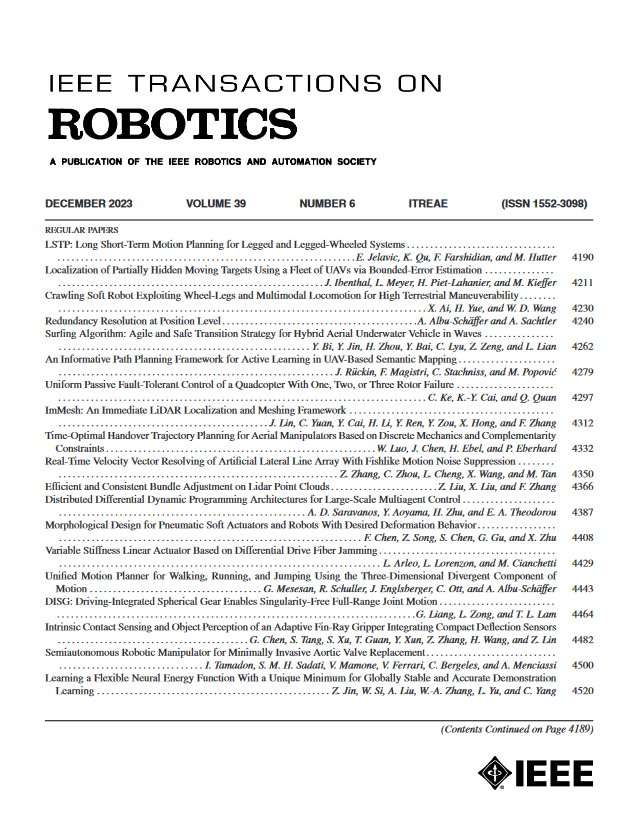用于无源导纳控制的双向能量流调制
IF 10.5
1区 计算机科学
Q1 ROBOTICS
引用次数: 0
摘要
导纳控制是实现机器人物理交互的一种控制方案,但它在机器人接触刚性表面时很容易引起不稳定。本研究对采用导纳控制的机器人系统进行了被动性分析。结果表明,如果消除了代理机器人与真实机器人之间的速度误差,就能确保与环境的耦合稳定性。因此,提出了一种自适应结构修改方法来抑制可能的不稳定源。此外,还将能量槽方法与所提出的方法相结合,以确保系统的被动性。作为概念验证,进行了三个机器人实验,并将所提方法的结果与传统的导纳控制和阻抗控制(带摩擦补偿)的结果进行了比较。比较结果表明,所提出的方法可以使系统处于被动状态,同时在交互过程中实现所需的动态效果。本文章由计算机程序翻译,如有差异,请以英文原文为准。
Bidirectional Energy Flow Modulation for Passive Admittance Control
Admittance control is a control scheme to enable physical interactions of a robot, but it easily induces instability when the robot contacts a rigid surface. In this study, a passivity analysis was conducted on a robotic system with admittance control. The results showed that coupled stability with the environment can be ensured when the velocity error between the proxy and the real robot is eliminated. Thus, an adaptive structure modification method is proposed to suppress the possible source of instability. In addition, the energy tank method is combined with the proposed method to ensure system passivity. As a proof of concept, three robot experiments were performed, and the results of the proposed method were compared with those of conventional admittance control and impedance control (with friction compensation). The comparison showed that the proposed method could make the system passive while realizing the desired dynamics during the interaction.
求助全文
通过发布文献求助,成功后即可免费获取论文全文。
去求助
来源期刊

IEEE Transactions on Robotics
工程技术-机器人学
CiteScore
14.90
自引率
5.10%
发文量
259
审稿时长
6.0 months
期刊介绍:
The IEEE Transactions on Robotics (T-RO) is dedicated to publishing fundamental papers covering all facets of robotics, drawing on interdisciplinary approaches from computer science, control systems, electrical engineering, mathematics, mechanical engineering, and beyond. From industrial applications to service and personal assistants, surgical operations to space, underwater, and remote exploration, robots and intelligent machines play pivotal roles across various domains, including entertainment, safety, search and rescue, military applications, agriculture, and intelligent vehicles.
Special emphasis is placed on intelligent machines and systems designed for unstructured environments, where a significant portion of the environment remains unknown and beyond direct sensing or control.
 求助内容:
求助内容: 应助结果提醒方式:
应助结果提醒方式:


